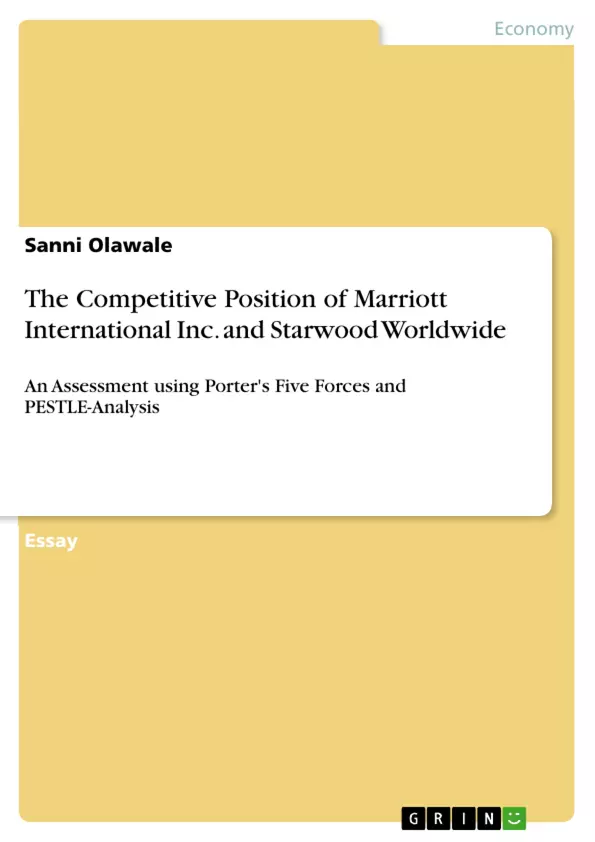This paper provides an assessment of the competitive position of the two companies Marriott International Inc. and Starwood Worldwide. It analyses how these companies compete with other market-competitors through strategic group control. The PESTEL framework provides an analysis concerning the external environment of the company, highlighting the economic, technological political and social influences that affect the environment. Meanwhile, Michael Porter's five forces are the frameworks that shape the competitive position of a firm.
Marriott International Inc. and Starwood Worldwide have been the leading franchiser, operator and licensor located in over 100 countries worldwide. In September 2016, the company announced the acquisition of Starwood Hotel and resorts to merge the world’s largest hotel companies under the name Marriott International Inc. Marriott International has a series of well-planned strategies such as advancing new generation travelers, portfolio strength, brand differentiation and technology leadership. This strategy is designed to compete with rival chains. In addition to this strategy, Marriott International has a strategy known as the "spirit of service to our community," which is a social approach to staying ahead of the competition.
The merger between Starwood and Marriott is a strategic move that not only builds more meaningful brands but also provides the most competitive advantage that helps them reach their goals and makes them competitive within the industry. It is well known that the implementation of effective strategies leads to better outcomes, through a coordinated approach, responding to local needs and problems, based on the best practices and existing strengths.
Marriott has made a strategical series of decision and actions to meet the objective of becoming the best hotel company in the world. It is the basis of establishing commercial enterprise, and it is essential for a company to survive and to sustain itself in today's changing environment, providing insights and encouraging its mission. Marriott International's business environment includes both internal and external factors that influence its performance and decision.
Table of Contents
- 1.0 Introduction
- 2.0 Related Strategic Evaluation
- 2.1 Corporate level strategy
- 2.2 Business level strategy
- 2.3 Functional level
- 3.0 Critical Evaluation of Key Stakeholders
- 3.1 Marriot's Stakeholders and Their Contributions towards Merger
- 3.2 The stakeholder theory
- 3.3 Application of stakeholder theory
- 4.0 External analysis uses PEST to identify and explore key trends
- 5.0 Industry analysis using Porter's five forces
- 5.1 Analysis by Marriott International, Inc. The service uses five (5) Porter Force models
- Barriers to entry
- 5.2 Implications of Porter Five Forces at Marriott International, Inc.
- 6.0 Conclusion
Objectives and Key Themes
This essay aims to provide a thorough assessment of Marriott and Starwood's competitive positioning and how they can compete with rivals by employing strategic group control. This analysis provides a strong understanding of the company's strategic direction.
- Strategic evaluation of Marriott and Starwood's merger and its impact on their competitive positioning
- Analysis of key stakeholders and their roles in the merger process
- Application of PESTEL analysis to identify external environmental factors impacting the industry
- Examination of Porter's Five Forces model to assess the competitive landscape of the hospitality industry
- Exploration of strategic group control as a means of achieving competitive advantage
Chapter Summaries
The introduction provides a background on the merger between Marriott International Inc. and Starwood Worldwide, highlighting their strategic goals and the importance of effective strategies for success in the hotel industry. It introduces PESTEL analysis and Porter's Five Forces as tools for evaluating the company's competitive position.
The second chapter delves into the strategic evaluation of the merger, examining its impact on the corporate, business, and functional levels of the organization. It discusses how the merger aligns the strengths of both firms to enhance their market competitiveness and their focus on the hotel industry.
Chapter three focuses on the critical evaluation of key stakeholders, exploring their contributions to the merger process. It introduces the stakeholder theory and its application in understanding stakeholder interests and their impact on the organization.
Chapter four delves into external analysis, utilizing PESTEL to identify and explore key trends shaping the industry. This chapter highlights the economic, technological, political, and social factors impacting Marriott's performance and decision-making.
Chapter five examines the industry analysis using Porter's Five Forces model, focusing on barriers to entry and its implications for Marriott International, Inc. This chapter provides a comprehensive assessment of the competitive landscape and its impact on the company's strategic decisions.
Keywords
The key focus topics of this essay are: Marriott International, Inc., Starwood Worldwide, merger, strategic evaluation, corporate level strategy, business level strategy, functional level strategy, stakeholder theory, PESTEL analysis, Porter's Five Forces, competitive advantage, strategic group control, hospitality industry.
- Quote paper
- Sanni Olawale (Author), 2020, The Competitive Position of Marriott International Inc. and Starwood Worldwide, Munich, GRIN Verlag, https://www.grin.com/document/932142



